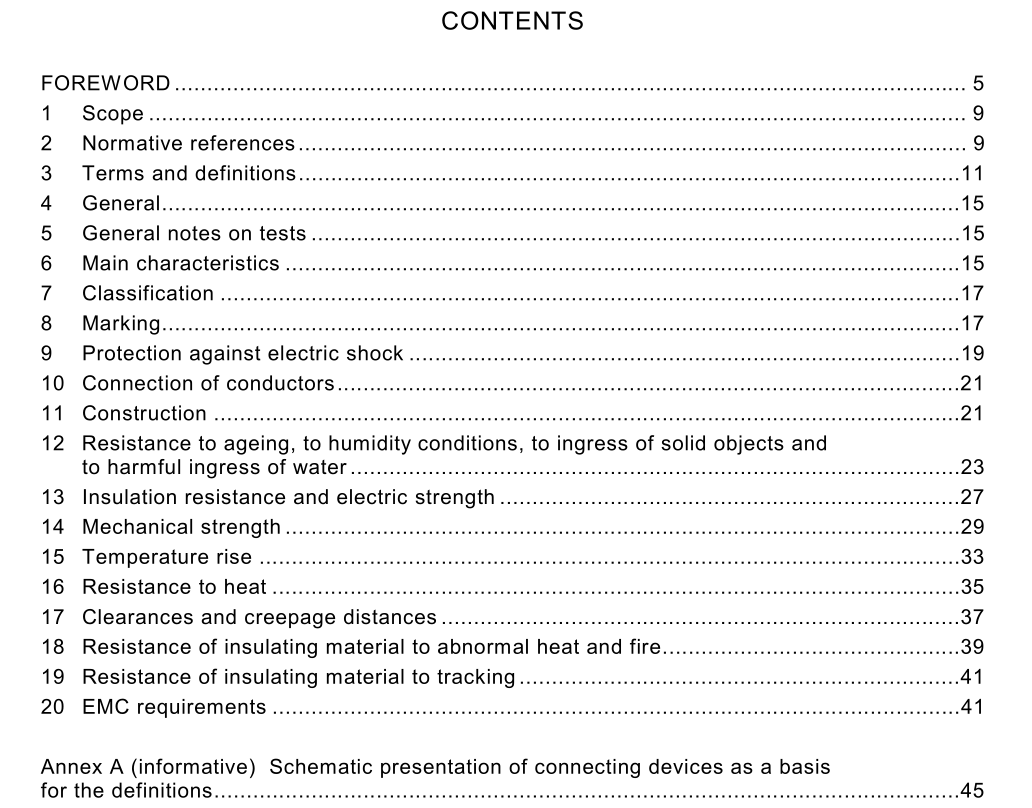IEC 60998-1 pdf download

IEC 60998-1 pdf download.Connecting devices for low-voltage circuits for household and similar purposes
1 Scope
This part of IEC 60998 applies to connecting devices as separate entities for the connection of two or more electrical copper conductors (complying with IEC 60228 or IEC 60344) rigid (solid or stranded) or flexible, having a cross-sectional area of 0,2 mm 2 up to and including 35 mm 2 and equivalent AWG conductors with a rated voltage not exceeding 1 000 V a.c. up to and including 1 000 Hz and 1 500 V d.c. where electrical energy is used for household and similar purposes. NOTE Rated connecting capacities lower than 0,5 mm 2 are referred to IEC 60344 and rated connecting capacities equal to, or higher than, 0,5 mm 2 are referred to IEC 60228. Connecting devices that require the use of special tools other than for twist-on connecting devices and insulation piercing connecting devices do not comply with this standard. This standard contains the general requirements to be used together with the relevant Part 2, containing detailed particular requirements for – devices with screw-type clamping units (IEC 60998-2-1); – devices with screwless-type clamping units (IEC 60998-2-2); – devices with insulation piercing clamping units (IEC 60998-2-3); – devices with twist-on connecting devices (IEC 60998-2-4); – devices with connecting boxes (junction and/or tapping) (IEC 60998-2-5).
3 Terms and definitions
For the purpose of this standard, the following definitions apply. 3.1 connection electrical connection between two or more conductors or between a conducting part and one or more conductors 3.2 junction connection between two or more conductor ends 3.3 tapping connection of a conductor end (called “tapped conductor”) on any point of another conductor (called “main conductor”) 3.4 connecting device device for the electrical connection of two or more conductors comprising one or more terminals and, if necessary, insulation and/or ancillary parts (see Annex A) 3.5 terminal conductive part of one pole composed of one or more clamping unit(s) and insulation if necessary (see Annex A) 3.6 clamping unit part(s) of a terminal necessary for the mechanical clamping and the electrical connection of the conductor(s), including the parts which are necessary to ensure correct contact pressure (see Annex A) 3.7 ancillary part part of a connecting device providing electrical and mechanical protection and/or mounting, for example, a base, an enclosure, a mounting rail, etc. (see Annex A) 3.8 rated connecting capacity cross-sectional area of the largest rigid conductor(s) to be connected as stated by the manufacturer of the connecting device. In the case of a connecting device for flexible con- ductors only, the rated connecting capacity is the cross-sectional area of the largest flexible conductor to be connected 3.9 rated insulation voltage voltage of a component, device or piece of equipment to which dielectric voltage tests and creepage distances are referred 3.10 rated current current assigned to the device by the manufacturer 3.11 clearance shortest distance in air between two conductive parts 3.12 creepage distance shortest distance along the surface of an insulating material between two conductive parts 3.13 ambient temperature temperature of the air surrounding the connecting device together with its enclosure, if any 3.14 temperature rise difference between the temperature of the part under test, together with its enclosure, if any, measured under load according to the test specification and the ambient temperature 3.15 multiway terminal device connecting device that consists of several terminals, insulated from each other in a common housing of insulating material, which are capable of being subdivided by the user to make connecting devices consisting of one or more terminals 3.16 unprepared conductor conductor which has been cut and the insulation of which has been removed over a certain length for insertion into a terminal NOTE A conductor, the shape of which is arranged for introduction into a terminal, or of which the strands are twisted to consolidate the end, is considered to be an unprepared conductor.









